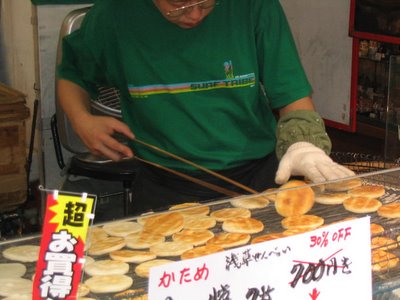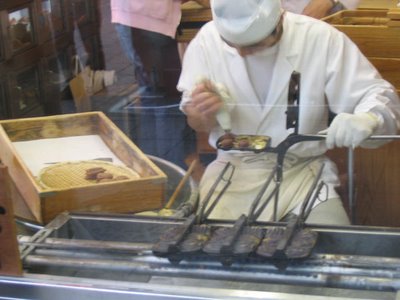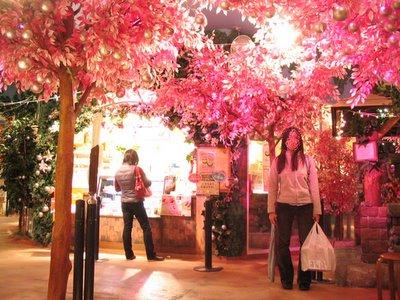| Day Six (Fri): | Shinjuku - Ueno - Kappabashi Dougugai - Asakasa - Jiyugaoka - Shibuya - Shinjuku |
| Breakfast: | Ebi Burger on a half price promotion Lotteria (burger chain), Shinjuku |
| Lunch: | Unagi Kabayaki at a 260-year-old specialist
|
| Dinner: | Various snacks and desserts Street stalls, Kameya Mannendo, Sweets Forest, mostly at Jiyugaoka |
Burger with a Japanese Twist - Part I
On this day we would sample Ueno's famous charcoal broiled eel - a Kanto peasant favorite for centuries. But first we needed the strength to dig our way through the long Yokochos of discount apparel and shoe stores of Ueno. In anticipation of a long day of emptying our wallets, we headed to Lotteria for some half-price Ebi Burgers.
No photo for the shrimp burger, but you can see a picture here. You can't beat this limited time half-price of 135 yen, and the shrimp patty was actually pretty good -- better than McDonald or KFC's fish burgers anyway.
Ueno's Market Alleys
Ueno is the home of the Tokyo National Museum (which was having a Hokusai exhibition at the time) and Ueno Zoo's giant panda. But we opted for a half day of shoe shopping instead.
There was a seemingly endless number of Yokochos, busy shopping alleys selling everything from traditional Mentaiko and Ichiyaboshi (semi-dried fish) to the latest Nike Shox. I'm not going into great details since you can get better info from places like this and this here. We ended up passing over the fishy items and buying two pairs of sneakers (one Nike, one Puma, the very latest styles) and one knapsack for a cheap total of 9000 yen. The really great thing was, three hours of rummaging through shoe stores was a good way to work up a big appetite for the much anticipated lunch.
Gourmet Spot #11: 260-Year-Old Unagi Specialist - Izuei Honten, Ueno

Hey it didn't look two-and-a-half centuries old! After all, it was rebuilt and rebuilt again, presumably after the many fires and earthquakes in Tokyo's long history. Today's Izuei Honten stands seven storeys high, with all seven floors serving the same item: Unagi.
With a soft, fatty texture, the Unagi is typically charcoal-broiled as
Kabayaki with a sweet glaze, but can also be "white broiled" without the
glaze. The fillet should be evenly-roasted without over-charring; the meat
should remain soft and only slightly oily, and the skin should be flavorful
and crispy. All depends on the quality of the eel and the charcoal, and of
course the skill of the chef...the old saying of "3 years to learn
filleting, 8 years of skewering, a lifetime of broiling"
summarizes the training of an Unagi chef.
To properly appreciate Unagi, one must first appreciate the difference between the two main schools of Unagi preparation: Kanto Ryu (East School) vs. Kansai Ryu (West School). Kanto Ryu chefs split the eel from the back side, and remove the head, backbone and fins before roasting. Then the eel is roasted, then steamed, then roasted again with a basting sauce. Kansai Ryu chefs split the eel from the belly side and removes the backbone only. The whole fish is then roasted for a prolonged period of time, without any steaming. It is said that Kanto Ryu produces a "feminine" taste of softer texture and subdued flavor, while Kansai Ryu produces a more "masculine" taste with a crispier, charred texture and flavor.

Like most Unagi specialists in Tokyo, Izuei follows the Kanto Ryu school of back-splitting and broil-steam-broil, although the precise technique is of course a guarded secret. We walked into the sweet smell of Unagi glaze and charcoal and were seated on the 2nd floor's tatami mats among patrons generally several decades our senior. We ordered two lunch sets: one Unatoro (Unagi with grated yam) Ju, and one Tono (gentleman) Ju.

My Tono Ju arrived with an Unagi fillet on rice, covered on top of another Unagi fillet on rice. This double portion Unaju was worth every yen.
I found that the main distinction of Izuei's Unagi was the the aromatic flavor of the charcoal smoke infused into the perfectly crisp (but not burnt) skin and soft fillet. There are a lot of other restaurants (not even Unagi specialists) that can do the Unagi glaze and skin very well, but the flavor and smell of Izuei's top quality charcoal was most memorable.
The set was complete with a Kimosui (Unagi liver soup) and Kounomono (pickles).

My wife had the Unatoro Ju, which came in this funky gourd-shaped bento box, with Kimosui and Kounomono on the side of course.

Appetizer - Maguro (NOT unagi! :)) sashimi.

Next up - Tororo, which was a very thick, cold broth with grated yam in a dashi base. My wife didn't like it but I thought it complimented the soft Unagi quite well.

And finally - The Unaju. "Only" single layer, but more than my wife could finish.
| Bill for two persons: | |
| Una Toro Ju | 2625 yen |
| Tono Ju | 3150 yen |
| (tax inclusive) | |
| Total | 5775 yen |
Kappabashi Dougugai
Remember those plastic ramen replicas you've seen outside of Japanese restaurants? Ever wonder where they're made or where to buy one to spook your dinner guests? The biggest concentration of these shops (well, three or four of them) are located at the Kappabashi Dori halfway between Ueno and Asakasa. It is also the place to get anything kitchen related, from cutlery to Rakuyaki pottery to Noren curtains. We ended up buying some bamboo utensils, plus one big bowl of replica Chashuu Ramen.
Asakusa
In the late afternoon we visited the big Tokyo tourist trap - the Sensoji at Asakusa. Besides taking the typical tourist photos of the huge lanterns and straw sandals, we came here to start our long, nomadic dinner. This would be our SNACK NIGHT, where we planned to sample the various Tokyoite snacking favorites we encounter on our path in place of a regular dinner.
Gourmet Spot #12: Desserts and Snacks for Dinner, Asakusa, Jiyugaoka, Shinjuku

Alright, dinner started at 3PM with a freshly roasted Senbei at 70 yen. This shop was located on the famous Nakamise Dori on the way to Sensoji, and was crowded with after school students looking for a cheap snack. Actually it was a bit too salty for my taste. I like my Senbei with more sweet Mirin on the glaze.

I should have started with these whatever-yaki instead. Delicious red bean paste...sweet Anpan was one of the many cuisine items I missed in this trip.

Or these! At 2268 yen it's hecka expensive for nine pieces of Wagashi. But these looked so enticing.
Instead, we got our dosage of red bean paste with a normal, 130 yen Matcha Daifuku from the same Wagashi-maker instead. It was only slightly sugary (just my taste - I hate overpoweringly sweet stuff), with a slight dash of salt to further draw out the sweetness. My wife, the huge Daifuku fan, loved it very much.
Jiyugaoka
After Asakusa we headed to the opposite side of Tokyo, to the western-influenced town of Jiyugaoka famous for its desserts. It is a place where traditional confectionery shops competes alongside Ice-cream stands and French pastries, and the competition has further intensified in recent years with the opening of the dessert theme park Sweets Forest.
To gradually adjust our tastebuds from the traditional Daifuku to the western dessert, we first visited a new-style (fusion?) Wagashi maker specializing in mixing western ingredients into traditional confectionery.
Kameya Mannendo

This 60-Year-Old contemporary Wagashi-maker is famous for its Italian-influenced Navona biscuits (its website is appropriately named navona.co.jp) and has been a fixture in Jiyugaoka for decades. Navona and other popular Omiyage items are sold on the ground floor while the second floor is a typical Kissaten, a romantic dessert bar ideal for a quiet read, or a first date.

My wife had the Shiratama Anmitsu, which was a bowl of thin, dark syrup filled with Shiratama (tiny Mochi balls), Anko (red bean paste), red beans, fruits, agar jelly, and sugar-coated Jelly Candies. That's right, Jelly Candies. Strange? Even more strange was how they blended in so nicely with all the Japanese confections in the bowl.
I didn't see anything else on the menu that interested me, so I ventured to order something I had absolutely no idea what it was. It was called Tokoroten, and the photo in the menu showed it as a bowl of semi-transparent jelly with some brown syrup. Hmmm...brown syrup...Okinawan brown sugar I hope?
Big mistake!

It was not a dessert! At least not MY definition of a dessert, which would consist of something sweet. It was agar jelly with dried seaweed, with mustard on the side, and a soy sauce vinegar to pour over the jelly. I'm not saying it was bad, it was only like going to a Italian Gelato shop and unknowingly ordering an anchovy-flavored ice-cream.
After I got back from the trip, I then learned that the Kansai version of Tokoroten would be actually sweet with a brown syrup...
Sweets Forest
Whew! I needed to remove that sour taste from my mouth, and so we went to the new Sweets Forest, well-known for bringing a large number of fine confectioners and patissiers all under the same roof.

We seemed to be hitting so many "date spots" in one day, as Sweets Forest turned out to be a dimly and colorfully illuminated, shaded (with artificial trees) indoor court yard half-filled with dating couples and high school girls in uniforms.
We were already quite full after the Shiratama and Tokoroten, and so we passed over the heavier desserts and cheesecakes (but I assure you they looked GOOD) and decided on a lighter dessert.

Hand mixed ice-cream. We ordered the Autumn specialty - sweet chestnuts with Matcha. It wasn't just chestnut or Matcha ice-cream, but pure unflavored ice-cream hand mixed with whole chestnut chunks and an intimidating amount of Matcha powder. There had to a whole cups of Matcha mixed into that one cone of ice-cream. As the menu description said, "perfect balance of the sweetness of Autumn chestnut and the bitterness of Matcha."

And the menu description was dead on, as the result was a surprisingly slightly sweet, slightly bitter ice-cream scattered with big chunks of super sweet chestnuts. It was a smooth, high quality ice-cream with an unforgettable (and unconventional) taste, and unlike the Tokoroten, we enjoyed it very much.
The Yakitori Van

Yup, Yakitori Van. Right when we walked out of the Sweets Forest and wanted a little non-sweet snack to rinse off the sugar on our tastebuds (we've been having nothing but desserts since mid-afternoon). This little van of a Yakitori stand parked just half a block from Sweets Forest, which sounds like a great strategy since the male half of the Sweets Forest's dating clientele probably prefer Tsukune chicken balls to choco-mousse.

Meat! The smell! After several hours of desserts everything on the counter looked really good. I was quite full though and had only one Yakitori and one Tsukune. Nothing spectacular, but at the time it was a godsend.
Hmm...Instant Ramen...
We took a Tokyu train back to Shibuya and had a brief walk inside the Tokyu department store, then returned to our hotel in Shinjuku. My wife wanted something more of a substantial meal (ie. enough of desserts!) without leaving the hotel room, and so it was time for another Tokyoite favorite...
Nissin Ramen! We grabbed whatever flavor offered by the hotel's convenient store, which were:


Menshokunin (noodle master) Tonkotsu Ramen, and...


Gonbuto Tempura Udon.
Instant noodles they might be, but still these were 300-yen-per-bowl noodles with six-step instructions. For the first time, the finished product actually looked like the picture on the packet! The Tonkotsu soup was very good considering it came out of a packet, and the udon was nice and chewy, complete with a piece of Kakiage tempura on the top.
| Bill for two persons: | |
| Fresh Roasted Senbei | 70 yen |
| Matcha Daifuku | 137 yen |
| Shiratama Anmitsu | ~950 yen |
| Tokoroten | ~650 yen |
| Matcha Chestnut Ice Cream | ~500 yen |
| Yakitori + Tsukune | 260 yen |
| Instant Ramen x 2 | ~600 yen |
| (tax inclusive) | |
| Total | ~3200 yen |
Crap! I just realized these so-called snacks were more expensive than the proper meals we had on Day 5!
Không có nhận xét nào:
Đăng nhận xét